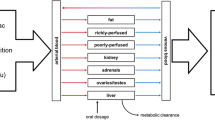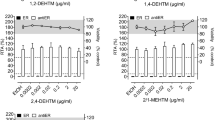Abstract
Purpose
The aim of this study is to use computational approaches to predict the ADME-Tox profiles, pharmacokinetics, molecular targets, biological activity spectra and side/toxic effects of 31 anabolic and androgen steroids in humans.
Methods
The following computational tools are used: (i) FAFDrugs4, SwissADME and admetSARfor obtaining the ADME-Tox profiles and for predicting pharmacokinetics;(ii) SwissTargetPrediction and PASS online for predicting the molecular targets and biological activities; (iii) PASS online, Toxtree, admetSAR and Endocrine Disruptomefor envisaging the specific toxicities; (iv) SwissDock to assess the interactions of investigated steroids with cytochromes involved in drugs metabolism.
Results
Investigated steroids usually reveal a high gastrointestinal absorption and a good oral bioavailability, may inhibit someof the human cytochromes involved in the metabolism of xenobiotics (CYP2C9 being the most affected) and reflect a good capacity for skin penetration. There are predicted numerous side effects of investigated steroids in humans: genotoxic carcinogenicity, hepatotoxicity, cardiovascular, hematotoxic and genitourinary effects, dermal irritations, endocrine disruption and reproductive dysfunction.
Conclusions
These results are important to be known as an occupational exposure to anabolic and androgenic steroids at workplaces may occur and because there also is a deliberate human exposure to steroids for their performance enhancement and anti-aging properties.



Similar content being viewed by others
Abbreviations
- AAS:
-
Anabolic androgen steroids
- ADME-Tox:
-
Absorption, Distribution, Metabolization, Excretion and Toxicity
- AR:
-
Agonistic conformation of the androgenic receptor
- AR an :
-
Antagonistic conformation of the androgenic receptor
- BBBP:
-
Blood brain barrier permeant
- ER α :
-
Agonistic conformation of the estrogen receptor alpha
- ER α an:
-
Antagonistic conformation of the estrogen receptor
- ER β:
-
Estrogen receptor beta
- ER β an :
-
Antagonistic conformation of the sstrogen receptor beta
- FDA:
-
Food and drug administration
- GI:
-
Gastrointestinal absorption
- GR:
-
Agonistic conformation of the glucocorticoid receptor
- GR an :
-
Antagonistic conformation of the glucocorticoid receptor
- hARLBD:
-
Human androgen receptor ligand-binding domain
- HSDB:
-
Hazardous substances data bank
- IUPAC:
-
International union of pure and applied chemistry
- LRX β:
-
Liver X receptor beta
- LXR α:
-
Liver X receptor alpha
- PASS:
-
Prediction of activity spectra of substances
- PDB:
-
Protein data bank
- P-gp:
-
P-glycoprotein
- PPRA α:
-
Peroxisome proliferator activated receptor alpha
- PPRA β:
-
Peroxisome proliferator activated receptor beta
- PPRA γ:
-
Peroxisome proliferator activated receptor gamma
- QSAR:
-
Quantitative structure-activity relationship
- RXR α :
-
Retinoid X receptor alpha
- TR α:
-
Thyroid receptor alpha
- TR β:
-
Thyroid receptor beta
References
Geyer H, Schänzer W, Thevis M. Anabolic agents: recent strategies for their detection and protection from inadvertent doping. Br J Sports Med. 2014;48(10):820–6.
Hall RC, Hall RC. Abuse of supraphysiologic doses of anabolic steroids. South Med J. 2005;98(5):550–5.
van Amsterdam J, Opperhuizen A, Hartgens F. Adverse health effects of anabolic-androgenic steroids. RegulToxicolPharmacol. 2010;57(1):117–23.
Kicman AT, Gower DB. Anabolic steroids in sport: biochemical, clinical and analytical perspectives. Ann ClinBiochem. 2003;40(4):321–56.
Cohen J, Collins R, Darkes J, Gwartney D. A league of their own: demographics, motivations and patterns of use of 1,955 male adult non-medical anabolic steroid users in the United States. J Int Soc Sports Nutr. 2007;4:12–2.
Maravelias C, Dona A, Stefanidou M, Spiliopoulou C. Adverse effects of anabolic steroids in athletes. A Constant ThreatToxicol Lett. 2005;158(3):167–75.
Kicman AT. Pharmacology of anabolic steroids. Br J Pharmacol. 2008;154(3):502–21.
Lippi G, Franchini M, Banfi G. Biochemistry and physiology of anabolic androgenic steroids doping. Mini Rev Med Chem. 2011;11(5):362–73.
Kersey RD, Elliot DL, Goldberg L, Kanayama G, Leone JE, Pavlovich M, et al. National Athletic Trainers Association Position Statement: anabolic-androgenic steroids. J Athl Train. 2012;47(5):567–88.
Nieschlag E, Vorona E. Mechanisms in endocrinology: medical consequences of doping with anabolic androgenic steroids: effects on reproductive functions. Eur J Endocrinol. 2015;173(2):R47–58.
Gronbladh A, Nylander E, Hallberg M. The neurobiology and addiction potential of anabolic androgenic steroids and the effects of growth hormone. Brain Res Bull. 2016;126(Pt 1):127–37.
Handelsman D. Androgen physiology, pharmacology and abuse. Philadelphia: Elsevier Saunder; 2016.
Fragkaki AG, Angelis YS, Koupparis M, Tsantili-Kakoulidou A, Kokotos G, Georgakopoulos C. Structural characteristics of anabolic androgenic steroids contributing to binding to the androgen receptor and to their anabolic and androgenic activities. Applied modifications in the steroidal structure. Steroids. 2009;74(2):172–97.
MacKrell JG, Yaden BC, Bullock H, Chen K, Shetler P, Bryant HU, et al. Molecular targets of androgen signaling that characterize skeletal muscle recovery and regeneration. NuclRecept Signal. 2015;13:e005.
Oberlander JG, Henderson LP. The Sturm und Drang of anabolic steroid use: angst, anxiety, and aggression. Trends Neurosci. 2012;35(6):382–92.
Pereira de Jésus-Tran K, Côté PL, Cantin L, Blanchet J, Labrie F, Breton R. Comparison of crystal structures of human androgen receptor ligand-binding domain complexed with various agonists reveals molecular determinants responsible for binding affinity. Protein Sci: Publ Protein Soc. 2006;15(5):987–99.
Alvarez-Ginarte YM, Crespo R, Montero-Cabrera LA, Ruiz-Garcia JA, Ponce YM, Santana R, et al. A novel in-silico approach for QSAR studies of anabolic and androgenic activities in the 17β-hydroxy-5α-androstane steroid family. QSAR Comb Sci. 2005;24(2):218–26.
Ciorsac AA, Popescu I, Isvoran A. Synthetic anabolic steroids binding to the human androgen receptor. Rom J Phys. 2015;60(7–8):1112–20.
Parr MK, Botrè F, Naß A, Hengevoss J, Diel P, Wolber G. Ecdysteroids: A novel class of anabolic agents? Biol Sport. 2015;32(2):169–73.
Joseph JF, Parr MK. Synthetic androgens as designer supplements. Curr Neuropharmacol. 2015;13(1):89–100.
Kim S, Thiessen PA, Bolton EE, Chen J, Fu G, Gindulyte A, et al. PubChem substance and compound databases. Nucleic Acids Res. 2016;44(D1):D1202–13.
Lagorce D, Sperandio O, Galons H, Miteva MA, Villoutreix BO. FAF-Drugs2: free ADME/tox filtering tool to assist drug discovery and chemical biology projects. BMC Bioinforma. 2008;9:396.
Kingsley LJ, Wilson GL, Essex ME, Lill MA. Combining structure- and ligand-based approaches to improve site of metabolism prediction in CYP2C9 substrates. Pharm Res. 2015;32(3):986–1001.
Daina A, Michielin O, Zoete V. SwissADME: a free web tool to evaluate pharmacokinetics, drug-likeness and medicinal chemistry friendliness of small molecules. Sci Rep. 2017;7:42717.
Cheng F, Li W, Zhou Y, Shen J, Wu Z, Liu G, et al. admetSAR: a comprehensive source and free tool for assessment of chemical ADMET properties. J ChemInf Model. 2012;52(11):3099–105.
Berman HM, Westbrook J, Feng Z, Gilliland G, Bhat TN, Weissig H, et al. The Protein Data Bank. Nucleic Acids Res. 2000;28(1):235–42.
Pettersen EF, Goddard TD, Huang CC, Couch GS, Greenblatt DM, Meng EC, et al. UCSF chimera--a visualization system for exploratory research and analysis. J Comput Chem. 2004;25(13):1605–12.
Grosdidier A, Zoete V, Michielin O. SwissDock, a protein-small molecule docking web service based on EADock DSS. Nucleic Acids Res. 2011;39(Web Server issue):W270–7.
Grosdidier A, Zoete V, Michielin O. EADock: docking of small molecules into protein active sites with a multiobjective evolutionary optimization. Proteins. 2007;67(4):1010–25.
Patlewicz G, Jeliazkova N, Safford RJ, Worth AP, Aleksiev B. An evaluation of the implementation of the Cramer classification scheme in the Toxtree software. SAR QSAR Environ Res. 2008;19(5–6):495–524.
Benigni R, Bossa C. Predictivity and reliability of QSAR models: the case of mutagens and carcinogens. ToxicolMech Methods. 2008;18(2–3):137–47.
Hengstler JG, Oesch F. Ames test. In: Encyclopedia of Genetics, eBrenner S, Miller JH, editors Academic Press; 2001. p. 51–54.
Kolsek K, Mavri J, SollnerDolenc M, Gobec S, Turk S. Endocrine disruptome--an open source prediction tool for assessing endocrine disruption potential through nuclear receptor binding. J ChemInf Model. 2014;54(4):1254–67.
Gfeller D, Grosdidier A, Wirth M, Daina A, Michielin O, Zoete V. SwissTargetPrediction: a web server for target prediction of bioactive small molecules. Nucleic Acids Res. 2014;42(Web Server issue):W32–8.
Poroikov V, Filimonov D, Lagunin A, Gloriozova T, Zakharov A. PASS: identification of probable targets and mechanisms of toxicity. SAR QSAR Environ Res. 2007;18(1–2):101–10.
Marwaha A, Goel RK, Mahajan MP. PASS-predicted design, synthesis and biological evaluation of cyclic nitrones as nootropics. Bioorg Med Chem Lett. 2007;17(18):5251–5.
Lagunin A, Filimonov D, Poroikov V. Multi-targeted natural products evaluation based on biological activity prediction with PASS. Curr Pharm Des. 2010;16(15):1703–17.
Goel RK, Singh D, Lagunin A, Poroikov V. PASS-assisted exploration of new therapeutic potential of natural products. Med Chem Res. 2011;20(9):1509–14.
Kuhn M, Letunic I, Jensen LJ, Bork P. The SIDER database of drugs and side effects. Nucleic Acids Res. 2015;44(D1):D1075–9.
Hishigaki H, Kuhara S. hERGAPDbase: a database documenting hERG channel inhibitory potentials and APD-prolongation activities of chemical compounds. Database (Oxford). 2011:bar017.
Alomar MJ. Factors affecting the development of adverse drug reactions. Saudi Pharm J. 2014;22(2):83–94.
Author information
Authors and Affiliations
Corresponding author
Additional information
Responsible editor: Kin Yip Tam, Zoran Mandic, and Tonglei Li
Rights and permissions
About this article
Cite this article
Roman, M., Roman, D.L., Ostafe, V. et al. Computational Assessment of Pharmacokinetics and Biological Effects of Some Anabolic and Androgen Steroids. Pharm Res 35, 41 (2018). https://doi.org/10.1007/s11095-018-2353-1
Received:
Accepted:
Published:
DOI: https://doi.org/10.1007/s11095-018-2353-1




